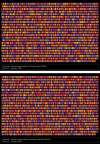Effect of high intratesticular estrogen on global gene expression and testicular cell number in rats
- PMID: 20573204
- PMCID: PMC2906496
- DOI: 10.1186/1477-7827-8-72
Effect of high intratesticular estrogen on global gene expression and testicular cell number in rats
Abstract
Background: The identification of estrogen receptors alpha and beta and aromatase in the testis has highlighted the important role of estrogens in regulating spermatogenesis. There is a wealth of information on the deleterious effects of fetal and neonatal exposure of estrogens and xenoestrogens in the testis, including spermiation failure and germ cell apoptosis. However, very little is known about gene transcripts affected by exogenous estradiol exposure in the testis. The objective of the present study was to unveil global gene expression profiles and testicular cell number changes in rats after estradiol treatment.
Methods: 17beta-estradiol was administered to adult male rats at a dose of 100 micrograms/kg body weight in saline daily for 10 days; male rats receiving only saline were used as controls. Microarray analysis was performed to examine global gene expression profiles with or without estradiol treatment. Real time RT-PCR was conducted to verify the microarray data. In silico promoter and estrogen responsive elements (EREs) analysis was carried out for the differentially expressed genes in response to estradiol. Quantitation of testicular cell number based on ploidy was also performed using flow cytometry in rats with or without estradiol treatment.
Results: We found that 221 genes and expressed sequence tags (ESTs) were differentially expressed in rat testes treated with estradiol compared to the control; the microarray data were confirmed by real time RT-PCR. Gene Ontology analysis revealed that a number of the differentially expressed genes are involved in androgen and xenobiotic metabolism, maintenance of cell cytoskeleton, endocytosis, and germ cell apoptosis. A total of 33 up-regulated genes and 67 down-regulated genes showed the presence of EREs. Flow cytometry showed that estradiol induced a significant decrease in 2n cells (somatic and germ cells) and 4n cells (pachytene spermatocytes) and a marked increase in the number of elongated and elongating spermatids.
Conclusions: This study provides a novel insight into the molecular basis for spermiation failure and apoptosis caused by 17beta-estradiol and it also offers new mechanisms by which adult exposure to environmental estrogens can affect spermatogenesis and fertility.
Figures




Similar articles
-
Time- and dose-related effects of estradiol and diethylstilbestrol on the morphology and function of the fetal rat testis in culture.Toxicol Sci. 2003 May;73(1):160-9. doi: 10.1093/toxsci/kfg065. Epub 2003 Mar 25. Toxicol Sci. 2003. PMID: 12657744
-
Estrogen receptor beta-mediated inhibition of male germ cell line development in mice by endogenous estrogens during perinatal life.Endocrinology. 2004 Jul;145(7):3395-403. doi: 10.1210/en.2003-1479. Epub 2004 Mar 24. Endocrinology. 2004. PMID: 15044378
-
Effect of estradiol on expression of cytoskeletal proteins during spermatogenesis in testis of sexually mature rats.Indian J Exp Biol. 2005 Nov;43(11):1068-79. Indian J Exp Biol. 2005. PMID: 16313069
-
Aromatase expression in male germ cells.J Steroid Biochem Mol Biol. 2001 Dec;79(1-5):203-8. doi: 10.1016/s0960-0760(01)00137-6. J Steroid Biochem Mol Biol. 2001. PMID: 11850226 Review.
-
Changes in MAPK pathway in neonatal and adult testis following fetal estrogen exposure and effects on rat testicular cells.Microsc Res Tech. 2009 Nov;72(11):773-86. doi: 10.1002/jemt.20756. Microsc Res Tech. 2009. PMID: 19565636 Review.
Cited by
-
Of Oestrogens and Sperm: A Review of the Roles of Oestrogens and Oestrogen Receptors in Male Reproduction.Int J Mol Sci. 2017 Apr 25;18(5):904. doi: 10.3390/ijms18050904. Int J Mol Sci. 2017. PMID: 28441342 Free PMC article. Review.
-
Altered phosphorylation and distribution status of vimentin in rat seminiferous epithelium following 17β-estradiol treatment.Histochem Cell Biol. 2011 Nov;136(5):543-55. doi: 10.1007/s00418-011-0856-5. Epub 2011 Sep 14. Histochem Cell Biol. 2011. PMID: 21915674
-
Spermiation: The process of sperm release.Spermatogenesis. 2011 Jan;1(1):14-35. doi: 10.4161/spmg.1.1.14525. Spermatogenesis. 2011. PMID: 21866274 Free PMC article.
-
Peroxiredoxin 6 Overexpression Induces Anxiolytic and Depression-Like Behaviors by Regulating the Serotonergic Pathway in Mice.Biomol Ther (Seoul). 2022 Jul 1;30(4):334-339. doi: 10.4062/biomolther.2021.169. Epub 2022 Mar 31. Biomol Ther (Seoul). 2022. PMID: 35354689 Free PMC article.
-
Tubulobulbar complex: cytoskeletal remodeling to release spermatozoa.Reprod Biol Endocrinol. 2012 Apr 17;10:27. doi: 10.1186/1477-7827-10-27. Reprod Biol Endocrinol. 2012. PMID: 22510523 Free PMC article. Review.
References
-
- Hess RA, Bunick D, Lubahn DB, Zhou Q, Bouma J. Morphologic changes in efferent ductules and epididymis in estrogen receptor-alpha knockout mice. J Androl. 2000;21:107–121. - PubMed
Publication types
MeSH terms
Substances
Grants and funding
LinkOut - more resources
Full Text Sources

